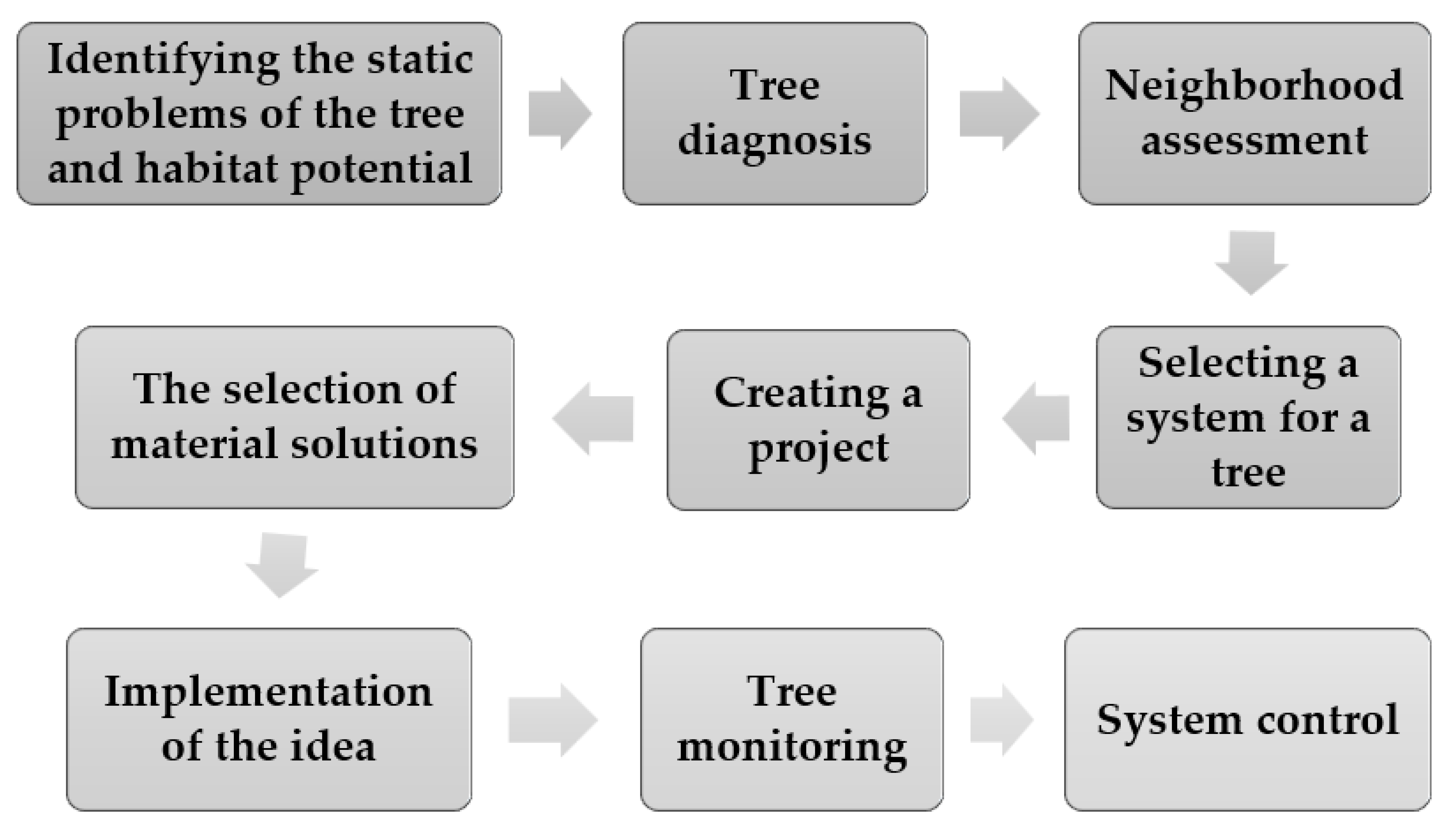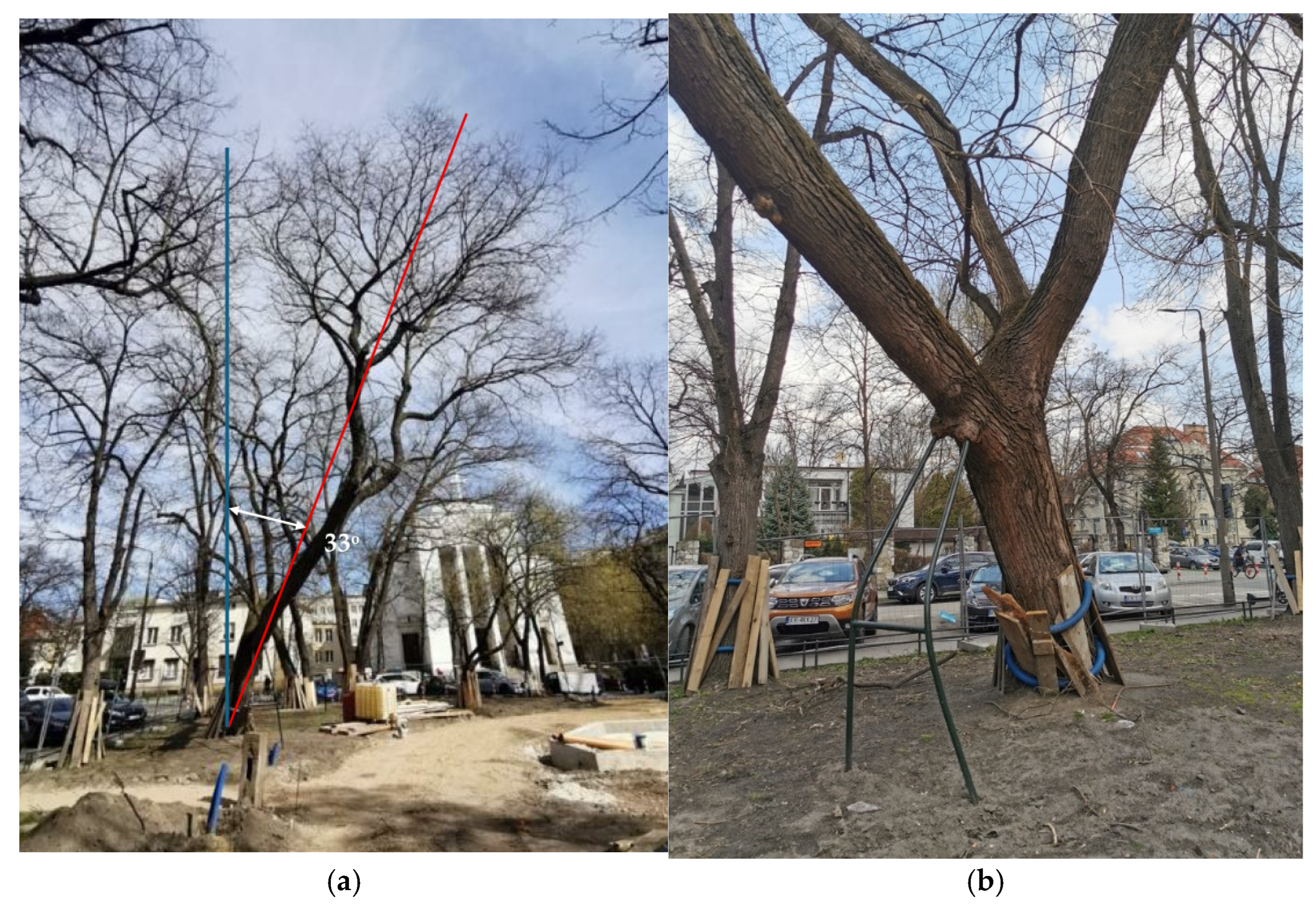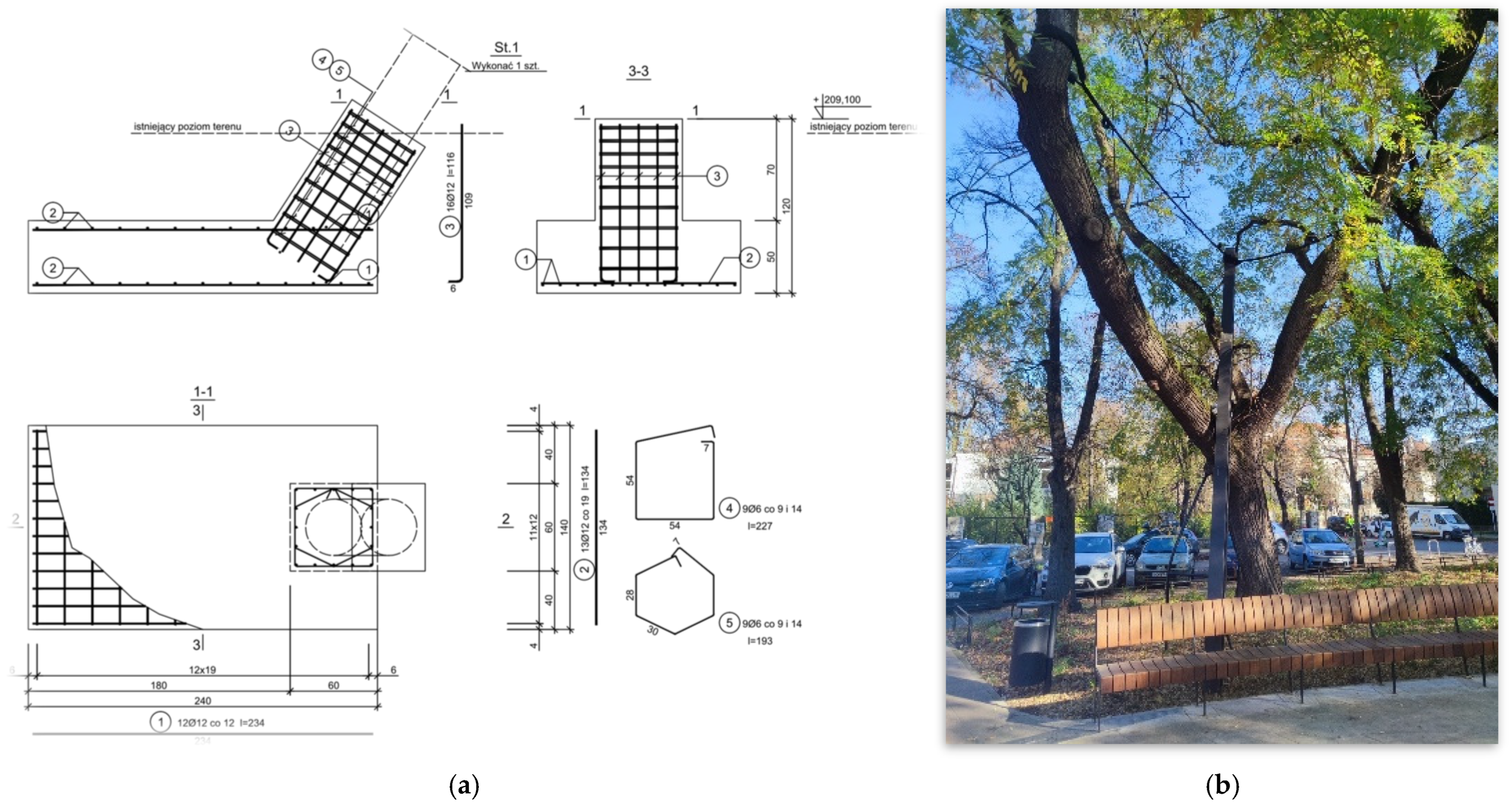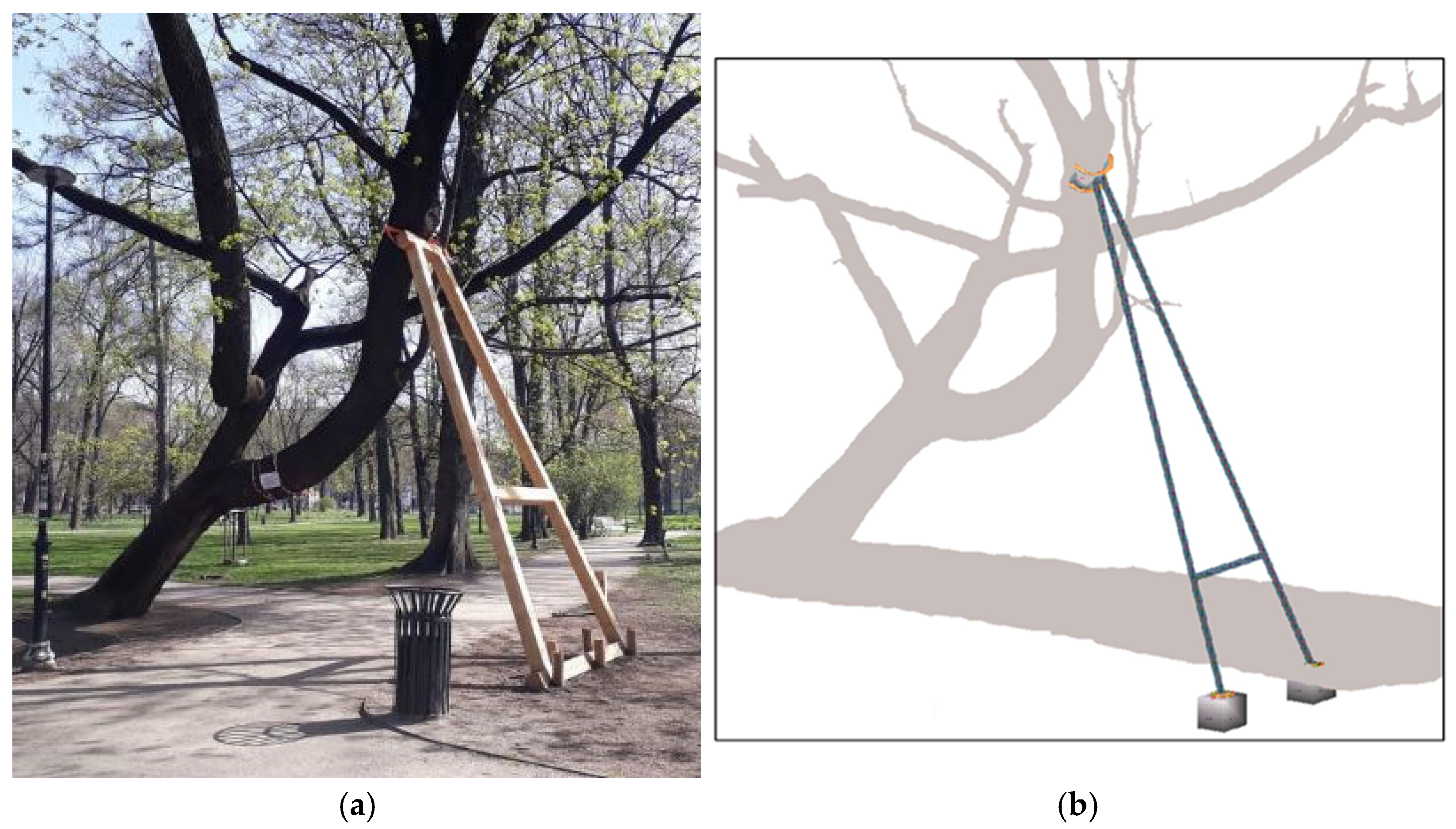Tree Supports—A Method for Managing the Protection of Habitat Trees, Increasing Biodiversity and the Resilience of Urban Ecosystems
Abstract
1. Introduction
- -
- Two walls, No. 1—the weakest, compartmentalising (fencing off) changes/decomposition from above and below
- -
- Wall No. 2—not very resistant, with compartmentalising changes or decomposition from the middle of the trunk or horizon.
- -
- Two walls, No. 3—moderately resistant, compartmentalising changes/distribution from the sides
- -
- Wall No. 4—named by Shigo “barrier zone”—the strongest, and compartmentalising changes/decomposition from outside the trunk/horizon.
2. Materials and Methods
3. Results
3.1. Beginning of the Implementation of the Method
3.2. Method Scheme
- Basic tree assessment based on standardised sensory assessment methods, which are being implemented throughout Europe [76] and guide most tree professionals. This allows advanced diagnosis of tree needs, allowing the next steps of the algorithm to be carried out efficiently.
- Wind load analysis is a calculation to determine the basic safety factor. It should be performed based on a photo or a cross-section of the tree obtained from a LIDAR scan. Such analysis can and should be combined with a sonic tomography of the trunk or a pulling test. This allows the mechanical parameters of the tree to be determined, which will serve as the basis for further structural calculations.
- Analyse the results of the tree condition in the context of the vulnerability of the surroundings, to assess which solution is the most optimal, not only for the tree itself, but also for the protection of the surroundings. Assessing the vulnerability of the surrounding environment is a fundamental element of comprehensive tree risk assessment methods [77,78].
- Modelling of the tree based on LIDAR scans, allowing effective selection of tree support solutions—supports or pylons. A well-prepared model enables greater design precision. In fact, it reduces the time required to produce and install a protective element. That makes a real difference in actively protecting valuable trees.
- The selection of the final protection solution allows for structural calculations and the choice of material solutions. It is essential to design a foundation with a limited impact on the root system. Optimal solutions should have the least possible impact on the tree’s current physiology. They should not block the reaction mechanisms of the wood, which are responsible for the construction of load-bearing structures.
- Model and visualise the solution for a specific tree, making it easier for decision makers to familiarise themselves with the chosen solution. This also facilitates the subsequent installation of the solution on the tree. This allows us to prepare the tree protection documentation.
- Carry out work on the tree to install the chosen protection solution. A contractor usually carries this out under the supervision of inspectors for the best tree protection.
- Monitoring the effects of the protection system and making adjustments if these prove necessary or if the tree develops significantly or deteriorates due to decay.
3.3. Selection of Trees for Analysing the Effectiveness of the Method
- -
- Important cultural context—Indian bean tree—Catalpa bignonioides—city centre, neighbourhood of the Museum of Polish Jews—Polin, Warsaw;
- -
- As an element of a modernist, nearly 100-year-old composition—Japanese pagoda tree—Styphnolobium japonicum—Axentowicz Square, Kraków; Kobus magnolia—Magnolia kobus—Skaryszewski Park, Warsaw;
- -
- As a witness to history—a tree that survived the bombing of the city during World War II—Black Locust—Robinia pseudoacacia—Piękna Street, Warsaw;
- -
- Important social and compositional context (Boxelder maples—Acer negundo—Agrykola Park and Wilson Square, Warsaw, Norway maple—Acer platanoides—Krakowski Park, Krakow.
3.4. Results of Measurements
3.5. Case Studies of the Implementation of the Methodology
4. Discussion
5. Conclusions
Funding
Data Availability Statement
Acknowledgments
Conflicts of Interest
Abbreviations
| CODIT | Compartmentalisation of Decay in Trees |
| LIDAR | Light Detection and Ranging |
| Bp | Basic Safety |
| SIM | Static Integrated Measurement—Pulling Test |
References
- Shigo, A.L. Some new ideas in tree care. J. Arboric. 1975, 1, 234–237. [Google Scholar] [CrossRef]
- Shigo, A.L.; Marx, H. CODIT: Compartmentalisation of Decay in Trees. In United States Department of Agriculture Forest Service Information Bulletin; U.S. Department of Agriculture: Washington, DC, USA, 1977; Volume 405, pp. 1–73. [Google Scholar]
- Shigo, A.L. Tree Decay: An Expanded Concept. In United States Department of Agriculture Forest Service Information Bulletin; U.S. Department of Agriculture: Washington, DC, USA, 1979; Volume 5, pp. 1–73. [Google Scholar]
- Hepting, G.H. Decay Following Fire in Young Mississippi Delta Hardwoods; USDA Technical Bulletin No. 494; U.S. Department of Agriculture: Washington, DC, USA, 1935; pp. 1–32. [Google Scholar] [CrossRef]
- Shigo, A.L. A New Tree Biology; Shigo and Trees Associates: Durham, UK, 1986; pp. 1–620. [Google Scholar]
- Shigo, A.L. Tree Pruning: A Worldwide Photo Guide; Shigo and Trees Associates: Durham, UK, 1988; pp. 1–194. [Google Scholar]
- Shigo, A.L. Modern Arboriculture; Shigo and Trees Associates: Durham, UK, 1991; pp. 1–424. [Google Scholar]
- Raghavendra, A.S. Physiology of Trees, 1st ed.; Wiley-Interscience: Oxford, UK, 1991; pp. 1–528. [Google Scholar]
- Romberger, J.A.; Hejnowicz, Z.; Hill, J.F. Plant Structure: Function and Development, 1st ed.; Springer: Berlin/Heidelberg, Germany, 1993; pp. 1–524. [Google Scholar]
- Dujesiefken, D.; Liese, W. The CODIT Principle: Implication for Best Practices; International Society of Arboriculture: Champaign, IL, USA, 2015; pp. 1–126. [Google Scholar]
- Dujesiefken, D.; Liese, W. The CODIT Principle: Implication for Best Practices, 2nd ed.; International Society of Arboriculture: Atlanta, GO, USA, 2025; pp. 1–220. [Google Scholar]
- Morris, H.; Hietala, A.M.; Jansen, S.; Ribera, J.; Rosner, S.; Salmeia, K.A.; Schwarze, F.W.M.R. Using the CODIT model to explain secondary metabolites of the xylem in defence systems of temperate trees to decay fungi. Ann. Bot. 2020, 125, 701–720. [Google Scholar] [CrossRef] [PubMed]
- Sinn, G. Standsicherheit von Bäumen. Das Gartenamt 1982, 31, 241–244. [Google Scholar]
- Sinn, G. Standsicherheit von Bäumen und Möglichkeiten der statischen Berechnung. Das Gartenamt 1983, 32, 665–672. [Google Scholar]
- Sinn, G.; Wessolly, L. A contribution to the proper assessment of the strength and stability of trees. Arboricultural. J. 1989, 13, 45–65. [Google Scholar] [CrossRef]
- Konijnendijk, C.C.; Nilsson, K.; Randrup, T.; Schipperijn, J. Urban Forests and Trees; Springer: Berlin/Heidelberg, Germany, 2005; pp. 1–504. [Google Scholar]
- Gutowski, J.M.; Bobiec, A.; Pawlaczyk, P.; Zub, K. Drugie Życie Drzewa (The Second Life of a Tree); WWF: Warsaw-Hajnówka, Poland, 2004; pp. 1–245. [Google Scholar]
- Witkoś-Gnach, K.; Tyszko-Chmielowiec, P. (Eds.) Trees—A Lifespan Approach. Contributions to Arboriculture from European Practitioners; Eco-Development Foundation: Wrocław, Poland, 2016; pp. 1–136. [Google Scholar]
- Fay, N.; de Berker, N. Ancient Trees and Their Value. In Trees—A Lifespan Approach. Contributions to Arboriculture from European Practitioners; Witkoś-Gnach, K., Tyszko-Chmielowiec, P., Eds.; Eco-Development Foundation: Wrocław, Poland, 2016; pp. 103–131. [Google Scholar]
- Haw, K. Wood Wise Woodland Conservation News; Woodland Trust: Grantham, UK, 2014; pp. 1–9. [Google Scholar]
- Ranius, T.; Johansson, P.; Berg, N.; Niklasson, M. The influence of tree age and microhabitat quality on the occurrence of crustose lichens associated with old oaks. J. Veg. Sci. 2008, 19, 653–662. [Google Scholar] [CrossRef]
- Bengtsson, V.; Hedin, J.; Niklasson, M. Veteranisation of Oak—Managing Trees to Speed Up Habitat Production. In Proceedings of the Trees Beyond the Wood Conference Proceedings, Sheffield, UK, 5–7 September 2012. [Google Scholar]
- Eckelt, A.; Müller, J.; Bense, U.; Brustel, H.; Bußler, H.; Chittaro, Y.; Cizek, L.; Frei, A.; Holzer, E.; Kadej, M.; et al. Primaeval forest relict beetles of Central Europe: A set of 168 umbrella species for the protection of primaeval forest remnants. J. Insect Conserv. 2018, 22, 15–28. [Google Scholar] [CrossRef]
- Cowan, A. Decaying Wood-Recycling in Arboreal Ecosystems, Working & Walking; Ian, D., Rotherham, I.D., Melvyn Jones, M., Christine Handley, C., Eds.; Wildtrack Publishing: Sheffield, UK, 2012; Volume 1, pp. 182–191. [Google Scholar]
- Aronson, M.; Lepczyk, C.; Evans, K.L.; Goddard, M.; Lerman, S.B.; MacIvor, J.S.; Nilon, C.H.; Vargo, T. Biodiversity in the city: Key challenges for urban green space management. Front. Ecol. Environ. 2017, 15, 189–196. [Google Scholar] [CrossRef]
- Goddard, M.; Dougill, A.; Benton, T. Scaling up from gardens: Biodiversity conservation in urban environments. Trends Ecol. Evol. 2010, 25, 90–98. [Google Scholar] [CrossRef] [PubMed]
- Bobek, W. Assessing risks caused by trees in historic gardens and park areas. In Threats Occurring in Historical Gardens of Countries in Central Europe; Hodor, K., Łakomy, K., Eds.; Politechnika Krakowska: Kraków, Poland, 2016; Volume 523, pp. 53–117. [Google Scholar]
- Grzywacz, A. Trees in the cultural landscape. Nat. Conserv. Manag. For. 2011, 5, 245–259. [Google Scholar]
- Pietrzak-Zawadka, J. Trees—Natural Monuments as an Element of the Tourist Function of the Area. In Areas of Natural Value in the Development of Tourism; Jalinik, M., Bakier, S., Eds.; Publishing House of the Białystok University of Technology: Białystok, Poland, 2020; pp. 114–125. [Google Scholar]
- Jackson, T.D.; Sethi, S.; Dellwik, E.; Angelou, N.; Bunce, A.; van Emmerik, T.; Duperat, M.; Ruel, J.C.; Wellpott, A.; Van Bloem, S.; et al. The motion of trees in the wind: A data synthesis. Biogeosciences 2021, 18, 4059–4072. [Google Scholar] [CrossRef]
- Sterken, P. A Guide for Tree-Stability Analysis, 2nd ed.; University and Research-centre of Wageningen, Blankenberge Sterken: Wageningen, The Netherlands, 2005; pp. 1–64. [Google Scholar]
- Wessolly, L.; Erb, M. Handbook of Tree Statics and Tree Inspection, 1st ed.; Patzer Verlag: Berlin-Hannover, Germany, 1998; pp. 1–178. [Google Scholar]
- Wessolly, L. Baumdiagnose—Eingehende Untersuchung mittels Zugersuch—Ergebnisse; Pro Baum: Göttingen, Germany, 2004; Volume 1, pp. 2–3. [Google Scholar]
- Bobek, W. Results of Tree Statics Research in the City As a Basis for Determining Risk Zones. Ph.D. Thesis, Cracow University of Technology, Kraków, Poland, 2013; pp. 1–173. [Google Scholar]
- Davenport, A.G. Wind Loads on Structures; Technical Paper Division of Building Research, DBR-TP-88; National Research Council of Canada: Ottawa, ON, Canada, 1960; pp. 1–98. [Google Scholar] [CrossRef]
- Mayhead, J. Some drag coefficients for British forest trees derived from wind tunnel studies. Agric. Meteorol. 1973, 12, 123–130. [Google Scholar] [CrossRef]
- Rust, S.; van Wassenaer, P. Tools for tree risk assessment. In Routledge Handbook of Urban Forestry; Routledge: Abingdon, UK, 2017; pp. 1–11. [Google Scholar]
- Palmer, J. Major Oak—Nottingham Forest. Available online: https://www.eyemead.com/majoroak.htm (accessed on 20 September 2022).
- Cocking, J. The need and principles for protecting veteran trees in Great Britain. J. Int. Soc. Cultiv. Prot. Trees 2011, 24, 56–73. [Google Scholar]
- Siewniak, M. The need to designate “veteran trees” among monumental trees. J. Int. Soc. Cultiv. Prot. Trees 2011, 24, 5–12. [Google Scholar]
- Zarzyński, P.; Tomusiak, R. Veteran trees in Poland. J. Int. Soc. Cultiv. Prot. Trees 2011, 24, 48–55. [Google Scholar]
- Siewniak, M.; Styczyński, S. Bartek, the Oak of Europe. J. Int. Soc. Cultiv. Prot. Trees 2011, 24, 85–89. [Google Scholar]
- Więckowski, Z.; Zwolski, A. Concept of additional supports to secure the “Bartek” oak and its branches and stiffenings of existing branch supports. J. Int. Soc. Cultiv. Prot. Trees 2011, 24, 107–113. [Google Scholar]
- Wessolly, L. Spectacular cases in tree safety inspections. J. Int. Soc. Cultiv. Prot. Trees 2011, 24, 90–106. [Google Scholar]
- Wężyk, P. Bartek Oak 3D—Ground-based 3D laser scanning of natural monuments—A new dimension of nature education. CEPL Stud. Mater. Rogów 2021, 43, 7–15. [Google Scholar]
- Siewniak, M. The need for total reinforcement of the veteran Bartek. In Proceedings of the Conference Bartek Oak among the Oldest Trees in Europe, Zagnańsk, Poland, 26 September 2016. [Google Scholar]
- Niklas, K.J.; Spatz, H.C. Plant Physics; University of Chicago Press: Chicago, IL, USA, 2012; pp. 1–448. [Google Scholar]
- Brudi, E.; van Wassenaer, P. Trees and Statics: Non-Destructive Failure Analysis. In Proceedings of the Tree Structure and Mechanics Conference: How Trees Stand Up and Fall Down, Savannah, GA, USA, October 2001; ISA: Champaign, IL, USA, 2002; pp. 53–70. [Google Scholar]
- Andersen, H.E.; Reutebuch, S.E.; McGaughey, R.J. A rigorous assessment of tree height measurements obtained using airborne lidar and conventional field method. Can. J. Remote Sens. 2006, 32, 355–366. [Google Scholar] [CrossRef]
- Henning, J.G.; Radtke, P.J. Detailed Stem Measurements of Standing Trees from Ground-Based Scanning Lidar. For. Sci. 2006, 52, 67–80. [Google Scholar] [CrossRef]
- Tompalski, P.; Kozioł, K. Determination of selected tree parameters using ground-based laser scanning. In Proceedings of the Conference: III Krakow Conference of Young Scientists, Krakow, Poland, 25–27 September 2008; Symposiums and Conferences KKMU No. 3. pp. 337–346. [Google Scholar]
- Pusztai, P. The Advantage of Point Cloud-Derived Tree Modelling on Urban Greenery Maintenance: Shortlisting Dangerous Trees, Assessing Ecosystem Services. Master’s Thesis, SMACCS, Bilbao, Spain, 2021. [Google Scholar]
- Wessolly, L. Materialkennwerte Grüner Hölzer (Stuttgarter Festigkeitskatalog); manuscript, University of Stuttgart, Stuttgart 1989; University of Stuttgart: Stuttgart, Germany, 1989. [Google Scholar]
- Fraser, I. Wind tunnel and other related studies on coniferous trees and tree crops. Scott. For. 1964, 18, 1–266. [Google Scholar]
- Dudkiewicz, M.; Durlak, W. Sustainable Management of Very Large Trees with the Use of Acoustic Tomography. Sustainability 2021, 13, 12315. [Google Scholar] [CrossRef]
- Wężyk, P.; Tompalski, P.; Szostak, M.; Glista, M.; Pierzchalski, M. Describing the selected canopy layer parameters of the Scots pine stands using ALS data. In Proceedings of the 8th International Conference on LiDAR Applications in Forest Assessment and Inventory, Silivi Laser 2008, Edinburgh, UK, 17–19 September 2008; pp. 636–645. [Google Scholar]
- Dudkiewicz, M.; Durlak, W. Sonic Tomograph as a Tool Supporting the Sustainable Management of Historical Greenery of the UMCS Botanical Garden in Lublin. Sustainability 2021, 13, 9451. [Google Scholar] [CrossRef]
- Qi, Y.; Foster, B.; Ferchaud, V.; Collins, D. Detecting Internal Decay in Trees Using Sonic Tomography Technology. Stn. Bull. Urban For. Nat. Resour. Environ. 2013, 605, 1–6. [Google Scholar]
- Rinn, F. Central defects in sonic tree tomography. West. Arborist 2016, 1, 39–41. [Google Scholar]
- Suchocka, M. Advantages and limitations of using the visual tree assessment (VTA) method as a response to problems related to threats caused by urban trees. Człowiek I Sr. 2012, 36, 97–110. [Google Scholar]
- Mattheck, C.; Bethge, K.; Weber, K. The body language of trees. In Encyclopedia of Visual Tree Assessment; Karlsruhe Institute of Technology—Campus North: Karlsruhe, Germany, 2015; pp. 404–405. [Google Scholar]
- Rinn, F. Principles and Challenges of Static Load Tests (‘Pull-Testing’) for Estimating Uprooting Safety; West Arborist: Santa Clara, CA, USA, 2017; pp. 36–41. [Google Scholar]
- Wessolly, L.; Erb, M. Handbuch der Baumstatik und Baumkontrolle, 2nd ed.; Patzer Verlag: Berlin-Hannover, Germany, 2014; pp. 1–288. [Google Scholar]
- Wessolly, L. Verfahren zur Bestimmung der Bruch-und Standsicherheit von Bäumen. Holz Als Roh-Und Werkst. 1991, 49, 99–104. [Google Scholar] [CrossRef]
- Wessolly, L.; Erb, M. Manual of Tree Statistics and Tree Inspection, 2nd ed.; Patzer Verlag: Berlin-Hannover, Germany, 2016; pp. 1–288. [Google Scholar]
- Peltola, H.M. Mechanical stability of trees under static loads. Am. J. Bot. 2006, 93, 1501–1511. [Google Scholar] [CrossRef] [PubMed]
- Marchi, L.; Grigolato, S.; Mologni, O.; Scotta, R.; Cavalli, R.; Montecchio, L. State of the Art on the Use of Trees as Supports and Anchors in Forest Operations. Forests 2018, 9, 467. [Google Scholar] [CrossRef]
- Peng, Y.-S.; Cheng, B.-Y.; Liu, T.-C. Mechanical Properties and Optimisation Strategies of Tree Fork Structures. Plants 2025, 14, 167. [Google Scholar] [CrossRef] [PubMed]
- Heyman, J. Design of a simple steel truss. Proc. Inst. Civ. Eng.—Struct. Build. 2010, 163, 53–56. [Google Scholar] [CrossRef]
- Brütting, J.; Desruelle, J.; Senatore, G.; Fivet, C. Design of Truss Structures Through Reuse. Structures 2019, 18, 128–137. [Google Scholar] [CrossRef]
- Passola, G. Apuntes de Raíces y de Trasplantes; Asociación Española de Arboricultura (AEA): Valencia, Spain, 2011; pp. 1–104. [Google Scholar]
- Bobek, W. Veteranisation of valuable trees in Waszngtona Avenue in Krakow as a method of ecological and cultural values synergistic protection. In Landscape Architecture Forum: Professional Practice, Scientific Research, Teaching; Ozimek, A., Sykta, I., Eds.; PK Publishing House: Krakow, Poland, 2021; pp. 24–38. [Google Scholar]
- Bobek, W. Problemy rewaloryzacji i pielęgnacji zabytkowych alei 3 Maja i Waszyngtona w Krakowie w dotychczasowej praktyce i w świetle nowych metod bezinwazyjnej diagnostyki dendrologicznej. Przyr. I Miast 2007, X, 322–327. [Google Scholar]
- Mrosla, L.; Fabritius, H.; Kupper, K.; Dembski, F.; Fricker, P. What grows, adapts and lives in the digital sphere? Systematic literature review on the dynamic modelling of flora and fauna in digital twins. Ecol. Model. 2025, 504. [Google Scholar] [CrossRef]
- EAS 04:2025; European Arboricultural Standards (EAS), Working Group “European Consulting Standards in Tree Work (ECoST). European Tree Assessment Standard: Kolín, Czech Republic, 2025.
- Smiley, E.; Matheny, N.P.; Lilly, S.J. Tree risk assessment. In Routledge Handbook of Urban Forestry; Routledge: Abingdon, UK, 2017; pp. 478–488. [Google Scholar]
- Li, H.; Zhang, X.; Li, Z.; Wen, J.; Tan, X. A review of research on tree risk assessment methods. Forests 2022, 13, 1556. [Google Scholar] [CrossRef]
- Bobek, W. Risk assessment methods based on tree statistics studies in the city. J. Int. Soc. Cultiv. Prot. Trees 2008, 18, 26–32. [Google Scholar]
- Siewniak, M.; Kusche, D. Baumpflege Heute, 6th ed.; Patzer Verlag: Berlin–Hannover, Germany, 2020; pp. 1–288. [Google Scholar]
- Lindenmayer, D.B. Conserving large old trees as small natural features. Biol. Conserv. 2017, 211, 51–59. [Google Scholar] [CrossRef]
- Hunter, M.L.; Acuña, V.; Bauer, D.M.; Bell, K.P.; Calhoun, A.J.; Felipe-Lucia, M.R.; Fitzsimons, J.A.; González, E.; Kinnison, M.; Lindenmayer, D.; et al. Conserving small natural features with prominent ecological roles: A synthetic overview. Biol. Conserv. 2017, 211, 88–95. [Google Scholar] [CrossRef]
- Fröhlich, A.; Ciach, M. Dead wood resources vary across different types of urban green spaces and depend on property prices. Landsc. Urban Plan. 2020, 197, 103747. [Google Scholar] [CrossRef]
- Piovesan, G.; Cannon, C.H.; Liu, J.; Munné-Bosch, S. Ancient trees: Irreplaceable conservation resource for ecosystem restoration. Trends Ecol. Evol. 2022, 37, 1025–1028. [Google Scholar] [CrossRef] [PubMed]
- Avilés, J.M. Pruning promotes the formation of an insufficient number of cavities for hollow-dependent birds in Iberian Holm-oak dehesas. For. Ecol. Manag. 2019, 453, 117627. [Google Scholar] [CrossRef]
- Großmann, J.; Pyttel, P.; Bauhus, J.; Lecigne, B.; Messier, C. The benefits of tree wounds: Microhabitat development in urban trees as affected by intensive tree maintenance. Urban For. Urban Green. 2020, 55, 126817. [Google Scholar] [CrossRef]
- Lonsdale, D. The recognition of functional units as an aid to tree management with particular reference to veteran trees. Arboric. J. 2013, 35, 188–201. [Google Scholar] [CrossRef]
- Yao, Q.; Wang, J.; Zhang, J.; Xiong, N. Error Analysis of Measuring the Diameter, Tree Height, and Volume of Standing Tree Using Electronic Theodolite. Sustainability 2022, 14, 6950. [Google Scholar] [CrossRef]
- Szlubowska, A.; Król, D.; Pietrzak, B. (Eds.) Tourism in Małopolskie Voivodship in 2022 and 2023; GUS: Kraków, Poland, 2024; pp. 1–71. Available online: http://krakow.stat.gov.pl (accessed on 25 October 2025).
- Fröhlich, A.; Przepióra, F.; Drobniak, S.; Mikusiński, G.; Ciach, M. Public safety considerations constrain the conservation of large old trees and their crucial ecological heritage in urban green spaces. Sci. Total Environ. 2024, 948, 174919. [Google Scholar] [CrossRef]






| Number of a Tree | Location | Species | Height | Circumference of Trunk | Crown Area | Wind Load Centre Height | Tipping/ Bending Moment | Basic Safety Bp |
|---|---|---|---|---|---|---|---|---|
| 1 | Krakow, Axentowicz Square | Japanese pagoda tree Styphnolobium japonicum | 21.5 m | 235 cm | 198.2 m2 | 12.9 m | 261 kNm | 243% |
| 2 | Krakow, Krakowski Park | Norway maple Acer platanoides | 22 m | 235 cm | 243.8 m2 | 11.9 m | 331.3 kNm | 233% |
| 3 | Warsaw, Polin Museum | Indian bean tree Catalpa bignonioides | 7 m | 168 cm | 32.9 m2 | 3.2 m | 15.8 kNm | 1121% |
| 4 | Warsaw, Piękna Street | Black locust Robinia pseudoacacia | 9 m | 146 cm | 50.1 m2 | 5.3 m | 27.1 kNm | 397% |
| 5 | Warsaw, Agrykola Park | Boxelder maple Acer negundo | 13.5 m | 186 cm | 135 m2 | 7 m | 160.8 kNm | 178% |
| 6 | Warsaw, Wilson Square | Boxelder maple Acer negundo | 14 m | 319 cm | 144 m2 | 7 m | 171.5 kNm | 1088% |
| 7 | Warsaw, Arkadia Park | Eastern crack-willow Salix euxina | 19 m | 466 cm | 284.2 m2 | 8.5 m | 328.8 kNm | 114% |
| 8 | Warsaw, Skaryszewski Park | Kobus magnolia Magnolia kobus | 13.5 m | 158 cm | 128.5 m2 | 6.3 m | 137.7 kNm | 143% |
| Tree Number | Foundation Dimensions [cm] | How the Tree Was Supported | Dimensions Profiles [mm] |
|---|---|---|---|
| 1 | 240 × 140 × 50 | Single, made of a traction pole. The pole consists of two C180 channels with ties. Two ties from the pylon to the trunks with GEFA 8t ropes. | C180 |
| 2.1 | Aggregate and wooden pegs, diameter 8 | Temporary, wooden, A-shaped. No adjustment. | 140 × 140 |
| 2.2 | 100 × 210 × 40 | A-shaped. Adjustment—spacer pads. | fi 88.9/5.0 |
| 3 | 90 × 50 × 30 | Two struts (external and internal). Adjustment—change in internal rod extension and screw lock. | external diameter 63.5/4.0 internal diameter 54/4.0 |
| 4 | 50 × 50 × 40 | Two seat posts (external and internal). Adjustment: Change the extension of the inner rod and secure it with a screw. | external diameter 63.5/4.0 internal diameter 54/4.0 |
| 5 | 50 × 50 × 40 | Consists of two seat posts (outer and inner). Adjustment—change in internal rod extension and screw lock. | external diameter 63.5/4.0 internal diameter 54/4.0 |
| 6 | 50 × 50 × 40 | Two seat posts (external and internal). Adjustment: Change the extension of the inner rod and secure it with a screw. | external diameter 70.0/4.0 internal diameter 60.3/4.0 |
| 7 | 50 × 50 × 40 | Two wooden posts fixed in square tube sockets. Internal posts are made of wood, and external posts form sockets. Adjustment involves extending the internal post and locking it with a screw. | C24, 70 × 70 R 80 × 3 |
| 8 | 200 × 70 × 40 | It consists of two rods (outer and inner). Adjustment: Change the extension of the inner rod and secure it with a screw. | external diameter 70.0/4.0 internal diameter 60.3/4.0 |
Disclaimer/Publisher’s Note: The statements, opinions and data contained in all publications are solely those of the individual author(s) and contributor(s) and not of MDPI and/or the editor(s). MDPI and/or the editor(s) disclaim responsibility for any injury to people or property resulting from any ideas, methods, instructions or products referred to in the content. |
© 2025 by the author. Licensee MDPI, Basel, Switzerland. This article is an open access article distributed under the terms and conditions of the Creative Commons Attribution (CC BY) license (https://creativecommons.org/licenses/by/4.0/).
Share and Cite
Bobek, W. Tree Supports—A Method for Managing the Protection of Habitat Trees, Increasing Biodiversity and the Resilience of Urban Ecosystems. Land 2025, 14, 2200. https://doi.org/10.3390/land14112200
Bobek W. Tree Supports—A Method for Managing the Protection of Habitat Trees, Increasing Biodiversity and the Resilience of Urban Ecosystems. Land. 2025; 14(11):2200. https://doi.org/10.3390/land14112200
Chicago/Turabian StyleBobek, Wojciech. 2025. "Tree Supports—A Method for Managing the Protection of Habitat Trees, Increasing Biodiversity and the Resilience of Urban Ecosystems" Land 14, no. 11: 2200. https://doi.org/10.3390/land14112200
APA StyleBobek, W. (2025). Tree Supports—A Method for Managing the Protection of Habitat Trees, Increasing Biodiversity and the Resilience of Urban Ecosystems. Land, 14(11), 2200. https://doi.org/10.3390/land14112200






